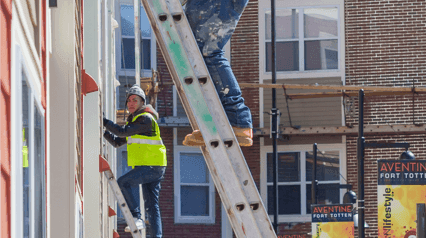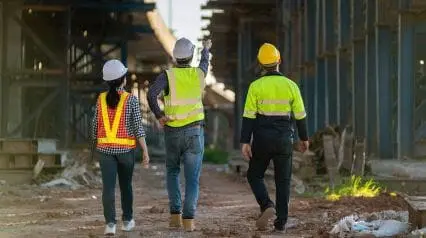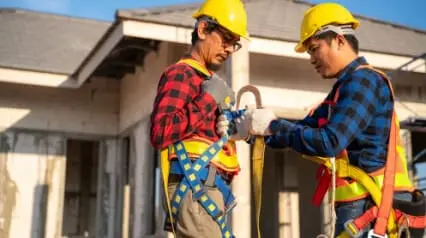What is Ladder Safety?
Ladder safety is a key aspect of fall prevention. According to the CDC, 81% of fall injuries, which is the leading source of fatalities among construction site workers, involve the use of ladders. As such, it’s important to remember and follow two of the common ladder safety best practices, which are 4 to 1 rule and the three points of contact rule.
When evaluating ladder safety, two things must be considered: the ladder type and the ladder height. Since fixed ladders are already securely attached to building structures, they are generally safer than portable ladders. As for ladder height, as pertaining to common sense, the higher the ladder, the higher the risk.
However, keep in mind that any work performed at 2 meters or above is considered working at height and requires sufficient fall protection such as a safety harness or a landing area.
Working at Height
Despite being one of the biggest causes of preventable work injuries and fatalities around the world, working at height is common in the construction industry. That being said, there are ways to mitigate the risk associated with working at height. Some general tips are providing quality equipment and gear for workers to use, training them on ladder safety and emergency procedures, and using working at height checklists to increase their awareness of the safety hazards involved in such work.
Working at Height Checklists
Working at height checklists are great tools to use when promoting ladder safety among construction site workers. Aside from being a convenient way to address safety concerns, a working at heights checklist also opens up the door to more meaningful conversations regarding construction site safety. Here are some working at height checklists that may be helpful to use:
Working At Height – Ladder Inspection Checklist
Use this template to assess the safety of ladders and minimize the number of falls caused by unsafe ladders. Record the ladder profile, labels, and parts. Capture photo evidence of damage, dents, and other defects with the ladder. Finally, rate the overall condition of the ladder and suggest recommendations.
Safety Harness Working At Height Template
Use this template to ensure fall protection by using a safety harness when working at height. Check the safety harness labels to determine the type, model, and date of manufacture. Capture photos of the safety harness and its components, such as snap hooks, lanyard, and tie-off adaptors/anchorages, to determine if it’s in good quality before use. Add a comment on the condition of the safety harness and request for a replacement, if needed.
Fall Protection
Fall protection could be the difference between life and death, injury and fatality, when it comes to working at height. In 2019, a Coachella worker fell to his death while setting up the stage, perhaps due to the lack of fall protection, as eyewitnesses claimed that he was not using a safety harness even while working at a height of 60-feet. Though it can be tempting to say that an incident such as this will not happen again, using fall protection is actually just the first step in ensuring construction site worker safety.
Fall Protection Checklists
Fall protection checklists are not only helpful in reminding workers to use a safety harness when on a greater than 2-meter ladder, but can also act as preventative maintenance, so that the daily wear and tear of fall protection equipment doesn’t damage its effectiveness. Go through these fall protection checklists before working at height to minimize the likelihood of ladder fall injuries:
Safety Harness Equipment Inspection Checklist
Use this template to ensure that a safety harness is in good condition before use. Take note of the intended usage and corresponding operating procedure of the safety harness. Inspect each part of the safety harness and its connections. Check the label of each component to identify the type of safety harness, its model, the manufacturing details, its limitations, and warnings before usage. Finally, determine whether or not the safety harness can still be used or should be removed from service. View a sample PDF report for more information.
Fall Protection Site Safety Inspection Report Form
Use this template to list safety measures before, during, and after shifts when working at height. Include a description of the work, photos, and personnel performing the task. Identify the safety measures in place such as permits, training, emergency exit routes, the working environment and the equipment provided. Check the safety harness to see if it is properly connected and operated. This template should be used in conjunction with the previous fall protection checklist. View a sample PDF report for more information.
Roof Safety
A defective ladder or safety harness is just one of many hazards faced by those who work on rooftops. Roofing is one of the most dangerous jobs in the construction industry, with falls from roofs accounting for 34% of all fall deaths. Aside from fall hazards such as an improperly placed ladder and faulty safety harness, other common roof safety hazards are power tools, electrical hazards (specifically power lines), hazardous substances like asbestos, and extreme temperatures, either from the heat of torches used for roofing or sudden changes in the weather. More often than not, roofers are forced to endure an unsafe working environment for the sake of completing the job and not losing the client. However, roofing can be safe with the right equipment.
Roof Safety Checklists
One equipment that’s free and easy to implement is a roof safety checklist. Construction workers and safety officers use these checklists to identify and document safety hazards when working on roofs. By conducting risk assessments and performing daily hazard identification, dangers to the safety of roofers can be eliminated through the implementation of controls. Here are some roof safety checklists that can aid in preventing falls from ladders used for roofing:
Roofing Work Safety Checklist – Toolbox Talk
Use this template before starting work on roofs. Record all the necessary details, instructions, communication protocols, and tasks to be performed. Discuss the hazards associated with work for the day and follow up on previous unresolved hazards. Remember, toolbox talks are intended to facilitate health and safety discussions, so it’s best to keep an open mind and let everyone speak up on the issues important to them and their work.
Roofing Risk Assessment Template
Use this template to effectively manage high risk activities on the construction site. Outline the likelihood and consequence of a hazard injury to determine its risk rating. Manage site safety by selecting an appropriate control measure from the hierarchy of controls. Capture photo evidence for recordkeeping or for future health and safety reports.
Construction Risk Assessment
Construction risk assessment is a critical examination of health and safety hazards at a construction site. One of these hazards, as stated previously, is an improperly placed ladder. While it may seem like such a minor detail in your site’s overall safety plan, following the 4 to 1 rule when setting up ladders and maintaining three points of contact when using them will certainly lower the site’s risk profile.
Construction Risk Assessment Checklists
As mentioned previously, injuries from falls are the most common cause of construction site fatalities. Incidents mainly account to the lack of fall protection and improper use of ladders. Other risks in construction are struck-by hazards, electrical hazards, and getting caught in or between objects. While occupational hazards in construction work cannot be completely eradicated, they can be identified, managed, and controlled with the use of risk assessment checklists like the ones below:
General Construction Risk Assessment Template
Use this template to document any potential hazards and risks in the construction site. Provide a brief description of the hazard and identify the procedures or equipment involved (i.e. working at height, scaffolding, PPE, LOTO procedures, crane/ forklift). Set assign and assign corrective measures and create construction risk assessment reports.
Construction Safety Observation Report
Use this template while taking a safety walk through the construction site. Identify areas/procedures and list them according to categories (Safety Mentions, Opportunities for Improvement, or Critical Items). Add notes, take photos, and annotate images to describe hazards.
Construction Safety
Of the ten most violated OSHA (Occupational Safety and Health Administration) standards, three belong to the construction industry, with ladders being one of them. OSHA has even released a publication entitled “Falling Off Ladders Can Kill: Use Them Safely” containing visual illustrations of ladder safety best practices. As ladder safety is but a single component of construction safety, using a digital tool to capture, identify, and manage all possible hazards would be ideal.
Construction Safety Checklists
Site supervisors and foremen use construction safety checklists to inspect the site for compliance to safety regulations, standards, and protocols. These checklists help keep workers safe and protected from hazards that may injure or kill them. Unlike paper, digital construction safety checklists are easy to access, edit, and implement among a large number of workers across multiple sites or locations, even offline.
Ladder Safety Checklist
Use this template to conduct safety checks by testing the ladder’s functionality and reliability. Ensure that the ladder has gone through proper inspection (before and after use) and identify defects that may cause potential risks such as falls.
Ladder Inspection Checklist
Use this template to ensure that a ladder passes quality and safety measures. Identify equipment defects before use to reduce risks and accidents such as cuts, bruises, or other severe injuries. Describe ladder type, length, class, and weight supported.
Ladder Set Up and Usage Checklist
Use this template to inspect if a ladder was set up and used properly during operations. Start by recording the nature of work and identifying the type of ladder used to perform the task. Then evaluate the process of setting up and climbing up a ladder. Lastly, provide recommendations to improve safety.
For more tips on ladder safety, inspection, set up and usage, check out the 3-step guide below:
Step 1 – Before Using a Ladder: Is It Safe?
In addition to choosing the right tool for the right job, you should be confident that the tool is safe to use. Before using a ladder ask yourself if you can perform the task without working from heights. If not possible, choose the correct ladder for the required task and height.
Check for tags and labels to know the use case of the ladder. Most importantly, inspect all parts for cracks, damages, bends or corrosions. Braces or ladder feet should be stable. Steps and rungs must be free from oils and dirts. Locks, bolts, rivets and other components should work perfectly. In case of any defects, label the ladder “Do Not Use” and report it to authorized people for repair or replacement.
By performing regular ladder equipment inspections, your team will feel assured that the tools they are choosing are safe to use.
Step 2 – Setting Up a Ladder: Should We Work?
There is no point in having safe to operate ladders if external conditions like weather, nearby hazards and setup are not assessed. These factors should be taken into consideration before we decide whether we commence work for the day.
First things first, always conduct a pre-start meeting or toolbox talk with your team to discuss all worksite hazards present before starting working. All workers should be trained and qualified, and should be aware of the emergency procedures if something goes wrong when operating ladders.
When setting up your ladder, choose the safest location and beware nearby hazards. Avoid working on a ladder during windy or wet conditions as this increases the chance of a ladder collapsing or causing slips and falls. Next, look for overhead power cables which could pose electrical hazards. Do not use a metal ladder if you think your work will involve the use of electrical equipment. Lastly, set your ladder only on even surfaces and if possible use a firm level footing.
Your team should always keep the shift supervisor updated on any high risks observed. Aborting work for the day is better than getting the team in danger.
Step 3 – Climbing Up a Ladder: Are You Ready?
More often than not, we tend to forget the proper ways of doing things when we think we are good at it. Using a ladder can seem second nature to most, however improper climbing techniques or even a slight distraction can result in falls, serious injury or death.
Here are 7 simple tips to help you minimize the risk of slipping or falling when climbing a ladder:
- Be attentive by watching your steps.
- Always keep yourself centered
- Use three points of contact. The climber must have two hands and one foot, or two feet and one hand in contact with the ladder steps, rungs and/or side rails at all times.
- Do not carry any loads or objects in either hand that can interfere with a firm grip on the ladder.
- Do not pull, lean, stretch or make sudden movements.
- Always use slip-resistant footwear.
- Observe the one person at a time rule.
Read more on general ladder safety rules.
Create Your Own Ladder Safety Checklist
Eliminate manual tasks and streamline your operations.
Get started for FREESafetyCulture Construction Site Inspection Software
SafetyCulture (formerly iAuditor) is a powerful construction site inspection software, allowing you to customize inspections, generate real-time reports, and create corrective actions on-the-go. Available on iOS and Android as a mobile app, SafetyCulture is free to download and even provides free access to thousands of checklists and templates for the construction industry. With SafetyCulture, you can conduct ladder safety inspections, construction risk assessments, training sessions, asset management, and more. SafetyCulture has the following features:
Create smart inspection forms – 3 options
- Convert your existing paper, PDF, Excel, or Word form into a digital checklist
- Use one of our premade customizable templates and adapt it to your needs
- Create a new template with our intuitive, drag-and-drop template builder
- Generate professional Web & PDF reports
- Assign corrective actions anytime to anyone
- Empower workers to flag issues instantly
- Get all the data you need in one dashboard
- Schedule recurring construction site inspections
FAQs About Ladder Safety
The 4 to 1 rule for ladder safety requires setting up the ladder in such a way that for every 4 feet of ladder height, the base of the ladder must be 1 foot away from the building, wall, or surface it is leaning against. This means that if a ladder is 16 feet tall, the base of the ladder should be placed four feet away from the surface it is leaning against, one foot away as the ladder height increases.
The three-point contact rule is a safety practice that means that either both feet and one hand or both hands and one foot should be in contact with the ladder at all times. The three points of contact must be maintained while working on top of the ladder. Possible points of contact are hands, knees, and feet. Each hand, knee, or foot counts as one point of contact.
Here are the steps to tie off a ladder for safety:
- Choose a secure anchor point – Look for a solid structure or immovable object to anchor the ladder to, such as a sturdy tree or a building column. It should also be at the same height as the top of the ladder.
- Secure the ladder – Wrap a rope or a firm strap around the ladder at a point about one-third of the way up from the bottom, then tie it securely to the anchor point using a knot such as a bowline or square knot. Make sure the ladder is level and stable before climbing.
- Add additional support – For added stability, you can also tie a second rope or strap around the ladder at a point near the top and secure it to the anchor point.
- Test for stability – Once the ladder is tied off, test it for stability by gently shaking it to make sure it is secure.
Yes, OSHA does require ladder safety training for employees who use ladders on the job. The OSHA regulations state that employers must provide safety training to all employees who use ladders or stairways so that they are able to proactively recognize hazards related to them. This also helps ensure that employees follow safe ladder practices while on the job.



